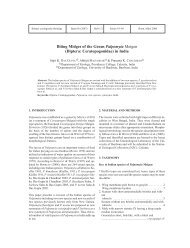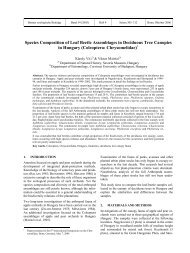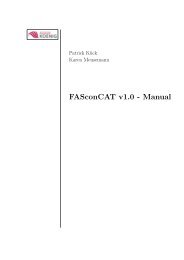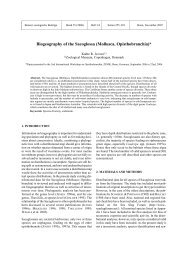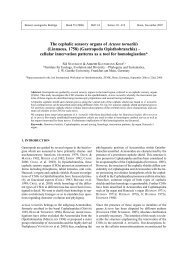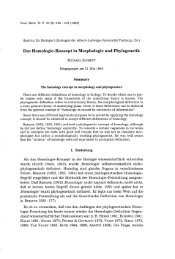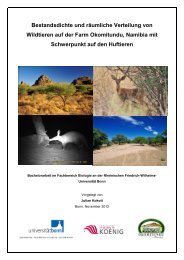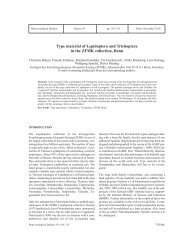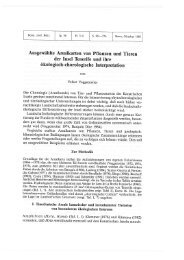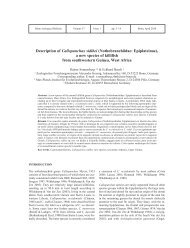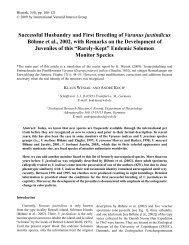Islands Between the Realms: A Revised Checklist of the ...
Islands Between the Realms: A Revised Checklist of the ...
Islands Between the Realms: A Revised Checklist of the ...
You also want an ePaper? Increase the reach of your titles
YUMPU automatically turns print PDFs into web optimized ePapers that Google loves.
124 André KOCH et al.: A <strong>Revised</strong> <strong>Checklist</strong> <strong>of</strong> <strong>the</strong> Herpet<strong>of</strong>auna <strong>of</strong> <strong>the</strong> Talaud Archipelago, Indonesia<br />
found during our biodiversity survey on Salibabu Island<br />
although this taxonomically difficult and diverse genus is<br />
well represented on <strong>the</strong> adjacent islands <strong>of</strong> Sulawesi,<br />
Halmahera and Mindanao (BROWN & ALCALA 1980;<br />
ISKANDAR & NIO 1996; MONK et al. 1997). In addition, flying<br />
lizards <strong>of</strong> <strong>the</strong> genus Draco were not observed during<br />
our field work, nor during previous expeditions to Salibabu<br />
Island (DE JONG 1928; MCGUIRE et al. 2007). In contrast,<br />
LAZELL (1992) predicted <strong>the</strong> sympatric occurrence <strong>of</strong> two<br />
Draco species for Talaud, one <strong>of</strong> which he assumed to be<br />
a giant, based on biogeographic knowledge <strong>of</strong> <strong>the</strong> Lesser<br />
Antilles Anolis lizards. Therefore, future field surveys concentrating<br />
on <strong>the</strong> forested areas <strong>of</strong> <strong>the</strong> larger island <strong>of</strong><br />
Karakelong are needed to verify <strong>the</strong> presence <strong>of</strong> Draco<br />
spp. on <strong>the</strong> Talaud <strong>Islands</strong>. The same applies to Gekko vittatus<br />
and Bronchocela jubata, which have been reported<br />
from Talaud in <strong>the</strong> past (see above). Fur<strong>the</strong>r unrecognized<br />
amphibian and reptile species may be anticipated to inhabit<br />
<strong>the</strong> Talaud Archipelago.<br />
As in many Pacific island biotas and beyond, Boiga irregularis,<br />
Gehyra mutilata, and Hemidactylus frenatus are<br />
most probably non-native, naturalized species <strong>of</strong> <strong>the</strong> Talaud<br />
Archipelago. Because <strong>the</strong>se reptiles are not utilized<br />
by man, <strong>the</strong>y have likely reached this island group via accidental<br />
human-mediated transportation. Never<strong>the</strong>less, <strong>the</strong><br />
ability to “use” boats and ferries for over-water dispersal<br />
renders <strong>the</strong>se three species as candidates to cross far distances<br />
on natural rafts as well. A determination between<br />
accidental human-mediated displacement on <strong>the</strong> one hand<br />
and natural colonization on <strong>the</strong> o<strong>the</strong>r seems virtually impossible.<br />
In any case, <strong>the</strong> new record <strong>of</strong> <strong>the</strong> invasive brown tree<br />
snake B. irregularis for Talaud may have severe consequences<br />
for <strong>the</strong> native vertebrate fauna <strong>of</strong> this island group.<br />
As was demonstrated by several studies (e.g., SAVIDGE<br />
1987; RODDA & FRITTS 1992; RODDA et al. 1997), this<br />
snake species is responsible for <strong>the</strong> dramatic decline in bird<br />
and lizard populations on Guam. This could be particularly<br />
fatal for endemic lizard species like <strong>the</strong> Talaud monitor<br />
lizards which have a very restricted distribution range<br />
(KOCH et al. subm.). SAVIDGE 1988 and MCCOID et al.<br />
(1994) reported from Guam that B. irregularis even preys<br />
on juveniles <strong>of</strong> Varanus indicus. Therefore, <strong>the</strong> development<br />
<strong>of</strong> <strong>the</strong> Talaud population <strong>of</strong> this invasive snake<br />
species deserves special attention in <strong>the</strong> future.<br />
Deforestation and destruction <strong>of</strong> natural habitats represent<br />
ano<strong>the</strong>r major threat to <strong>the</strong> amphibians and reptiles <strong>of</strong> <strong>the</strong><br />
Talaud Archipelago as was pointed out by RILEY (2002)<br />
for <strong>the</strong> mammals <strong>of</strong> this island group. Coconut plantations<br />
replace natural vegetation in most areas. Therefore, a<br />
wildlife reserve has been established on <strong>the</strong> larger island<br />
<strong>of</strong> Karakelong to protect endemic faunas (RILEY 1997).<br />
Biogeographic relations and past dispersal routes<br />
Although it may seem premature, some conclusions can<br />
be drawn about <strong>the</strong> biogeographic origin and affinities <strong>of</strong><br />
<strong>the</strong> Talaud <strong>Islands</strong>’ herpet<strong>of</strong>auna based on current distribution<br />
patterns <strong>of</strong> amphibians and reptiles <strong>of</strong> <strong>the</strong> Indo-Australian<br />
Archipelago. Firstly, several typical Australopapuan<br />
species or species groups (viz. Litoria infrafrenata, Candoia<br />
paulsoni, Nactus cf. pelagicus, Eugongylus rufescens,<br />
Lipinia noctua, and Varanus sp. [aff. indicus]), reach <strong>the</strong>ir<br />
most north-western distributions on <strong>the</strong> Talaud <strong>Islands</strong>.<br />
These Australopapuan faunal elements probably arrived<br />
at this island group via Halmahera and adjacent islands in<br />
<strong>the</strong> nor<strong>the</strong>rn Moluccas. Some species with Oriental origin,<br />
such as Eutropis multifasciata and Eutropis cf. rudis, have<br />
<strong>the</strong>ir most easterly distribution on or around <strong>the</strong> Talaud <strong>Islands</strong>.<br />
Consequently, <strong>the</strong> Talaud Archipelago’s biogeographic<br />
position within <strong>the</strong> Wallacea transition zone is<br />
clearly warranted (see COX 2001 for a recent review <strong>of</strong> <strong>the</strong><br />
Wallacea region). Interestingly, few widespread Oriental<br />
species like Varanus salvator did not reach <strong>the</strong> Talaud<br />
Archipelago despite its abundance on Sulawesi and smaller<br />
<strong>of</strong>f-shore islands. An explanation for this may be <strong>the</strong><br />
flow <strong>of</strong> Pacific water into <strong>the</strong> Indian Ocean via <strong>the</strong> Indonesian<br />
seas. This throughflow enters <strong>the</strong> Indonesian <strong>Islands</strong><br />
in north-eastern to south-western direction between Mindanao<br />
and <strong>the</strong> Talaud group passing <strong>the</strong> Celebes Sea while<br />
ano<strong>the</strong>r sea current from <strong>the</strong> Pacific circulates between Talaud<br />
and Halmahera (GORDON & FINE 1996, GORDON<br />
2005), thus hampering over-water dispersal on natural<br />
rafts.<br />
Secondly, <strong>the</strong> herpet<strong>of</strong>auna <strong>of</strong> Talaud shows clear biogeographic<br />
relations to Halmahera in <strong>the</strong> nor<strong>the</strong>rn Moluccas<br />
and, to a lesser extent, to Sulawesi and to <strong>the</strong> Philippines.<br />
With <strong>the</strong> nor<strong>the</strong>rn Moluccas <strong>the</strong> Talaud Archipelago has<br />
20 amphibian and non-marine reptile species in common,<br />
while it shares only 14 amphibians and non-marine reptiles<br />
with Sulawesi and <strong>the</strong> Philippines, respectively (see<br />
Tab. 1). With regard to amphibians, two out <strong>of</strong> three Talaud<br />
species also occur on Halmahera and, at least in one<br />
case (Litoria infrafrenata), far<strong>the</strong>r sou<strong>the</strong>ast on New<br />
Guinea and adjacent islands. In contrast, no frog species<br />
from <strong>the</strong> Philippines seem to have reached <strong>the</strong> Talaud <strong>Islands</strong>.<br />
Limnonectes modestus which inhabits Sulawesi is<br />
also found on <strong>the</strong> Talaud <strong>Islands</strong> and some islands <strong>of</strong> <strong>the</strong><br />
Moluccas. For <strong>the</strong> terrestrial reptiles, four species (respectively<br />
five when Gekko vitattus is included) are exclusively<br />
shared by <strong>the</strong> Talaud Archipelago and <strong>the</strong> nor<strong>the</strong>rn<br />
Moluccas including areas fur<strong>the</strong>r sou<strong>the</strong>ast. These are Candoia<br />
paulsoni tasmai, Nactus cf. pelagicus, Eugongylus<br />
rufescens, and Lipinia noctua.<br />
Due to <strong>the</strong>ir central position in <strong>the</strong> Molucca Sea, <strong>the</strong>re are<br />
no native species exclusively common to <strong>the</strong> Talaud Is-




